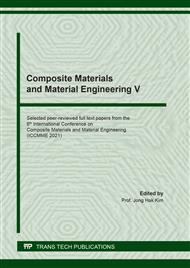p.3
p.9
p.15
p.21
p.27
p.32
p.38
p.44
Mechanical Properties and Thermal Analysis of Salago and Coir Hybrid Fiber Reinforced Epoxy Resin Composites
Abstract:
The utilization of natural fibers in composites continues to increase due to their advantages over the synthetic fiber materials especially in terms of environmental impact and costs. One of the techniques that can be used to further enhance the properties of these natural fiber reinforced composites is through fiber hybridization. In this study, salago and coir fibers were reinforced in the epoxy resin to form a new hybrid composite. The salago to coir fiber weight ratios considered in the fiber hybridization were 3:1, 1:1 and 1:3. The performance of these hybrid fiber composites were compared to pure coir fiber composite and salago fiber composite in terms of impact strength, tensile properties and flexural properties. Among the hybrid fiber composites, the fiber weight ratio of 3:1 has the highest tensile strength (33.8 MPa), tensile modulus (3.57 GPa), flexural strength (44.2 MPa) and impact strength (42.3 J/m). It was found out that the addition of coir to this hybrid fiber composite improves the tensile strength by about 21.1 % as compared to the salago fiber composite. On the other hand, the addition of salago fiber to this hybrid fiber composite resulted to a higher tensile modulus (43.4 %) and impact strength (25.5 %) than the coir fiber composite. Moreover, the thermal analysis of the composites revealed a peak degradation temperature at around 370 °C which is associated to the decomposition of cellulose, hemicellulose and epoxy resin.
Info:
Periodical:
Pages:
3-8
Citation:
Online since:
June 2021
Authors:
Keywords:
Price:
Сopyright:
© 2021 Trans Tech Publications Ltd. All Rights Reserved
Share:
Citation:


